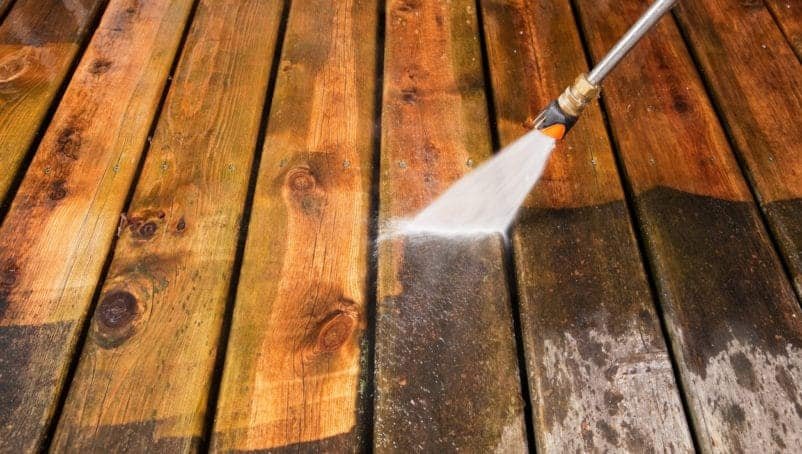
Mold and mildew can turn a beautiful surface into an unsightly, smelly mess. Whether it’s your deck, driveway, siding, or fence, one of the most common questions people ask is: Will power washing kill mold and mildew permanently?
The short answer is: Power washing can remove mold and mildew, but it doesn’t guarantee they won’t come back. To prevent regrowth, you’ll need more than just water pressure — you need the right tools, techniques, and aftercare. Let’s break it all down. 🧪🌿
🧬 What’s the Difference Between Mold and Mildew?
Before we dive into removal, let’s clarify the difference:
- Mildew is a surface-level fungus that appears as a powdery white, gray, or yellow patch. It’s easier to remove and typically less harmful.
- Mold is darker (black, green, or brown), grows deeper into surfaces, and can pose health risks like allergies or respiratory issues.
Both thrive in moist, shaded areas — making decks, patios, fences, and siding prime targets. 🌧️🌳
💦 Does Power Washing Kill Mold and Mildew?
Power washing removes mold and mildew spores from surfaces, often eliminating visible stains and growth. However:
- High-pressure water alone doesn’t kill mold at its roots
- Mold spores can still remain in porous materials like wood and concrete
- Without treatment, mold and mildew can return — sometimes within weeks 😬
Think of power washing as the first step in a multi-step process.
Browse Amazon Here For Top Rated Power Washers And Accessories
🧪 What You Need to Truly Kill Mold and Mildew
To make your cleaning effort long-lasting, pair your power washer with one of these mold-killing solutions:
1. Mold-Killing Detergents
Look for cleaners labeled specifically for mold, mildew, and algae. These penetrate the surface and break down spores.
2. Bleach-Based Cleaners
A diluted bleach solution (1 part bleach to 10 parts water) can kill most mold spores on non-porous surfaces. However, bleach should be used carefully — it can harm plants and fade colored surfaces.
3. Vinegar or Hydrogen Peroxide
Great for environmentally friendly cleaning, these alternatives are less harsh and still effective — though slower acting.
Important: Let the solution dwell for 5–10 minutes before rinsing. This gives it time to kill spores, not just rinse them off. ✅
Browse Amazon Here For Popular Mold And Mildew Cleaners
🔧 Step-by-Step: Power Washing Mold and Mildew
- Identify affected areas — Look for discoloration, musty smells, or slippery textures.
- Pre-wet nearby plants — Protect landscaping by soaking it before applying chemicals.
- Apply mold-killing detergent — Use a pump sprayer or soap injector.
- Let it dwell — Give it 5–15 minutes to penetrate mold roots.
- Power wash with moderate pressure — 1,200–2,000 PSI is usually effective.
- Rinse thoroughly — Remove all detergent residue.
- Let the area dry fully — Moisture invites mold back, so allow 24–48 hours to dry.
🧱 How Surface Type Affects Mold Growth
Mold and mildew behave differently depending on the material:
| Surface | Risk Level | Porous? | Needs Chemical Cleaner? |
|---|---|---|---|
| Wood decks | High | Yes | Yes |
| Concrete patios | Moderate | Yes | Yes |
| Vinyl siding | Low to Moderate | No | Optional |
| Brick walls | High | Yes | Yes |
| Outdoor furniture | Varies | Depends | Often |
Porous surfaces absorb moisture and spores, making them more vulnerable to regrowth.
🌬️ How to Prevent Mold and Mildew From Coming Back
Power washing plus treatment is great — but prevention is even better. Here’s how to keep mold and mildew from returning:
- 🌞 Increase sunlight exposure – Trim back trees and bushes to allow more light in
- 🌬️ Improve airflow – Mold loves stagnant air. Use fans in tight corners or under decks.
- 🌧️ Improve drainage – Avoid puddling by grading land away from structures
- 🧴 Apply a mold-resistant sealer – Great for wood and masonry surfaces
- 🧹 Clean regularly – Sweep, rinse, or hose down surfaces to prevent buildup
The more proactive you are, the less frequently you’ll need to treat mold with chemicals or power washing.
🧠 Pro Tips for Long-Term Mold Management
- ✅ Use a rotating surface cleaner to evenly clean patios and decks
- ✅ Clean in the spring and again in the fall if you live in a damp climate
- ✅ Always wear protective gear when using bleach or mold-killing solutions
- ✅ Consider zinc or copper strips on roofs or fences — they naturally fight mold and algae
🛑 What Not to Do
- ❌ Don’t rely on water pressure alone — spores will survive
- ❌ Don’t power wash damaged wood or loose siding — it could cause more harm
- ❌ Don’t skip drying — dampness is a mold magnet
- ❌ Don’t overuse bleach — it can cause surface damage and kill plants
🏁 Final Thoughts
So, will power washing kill mold and mildew permanently? Not by itself — but with the right cleaning agents and preventive steps, you can drastically reduce the chance of mold coming back.
Power washing removes the surface growth and preps the area. What happens next — how you treat and maintain the space — is what keeps it clean long-term. 🍃✨
Take the time to do it right, and you’ll enjoy a mold-free patio, deck, or driveway for months (or even years) to come. 💪🍄🧼






